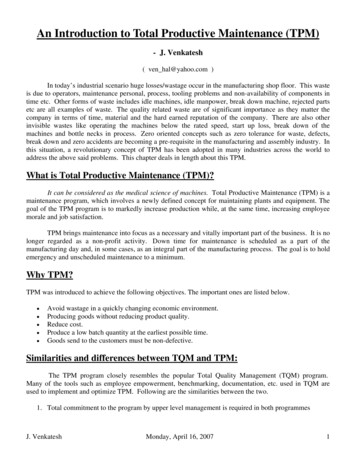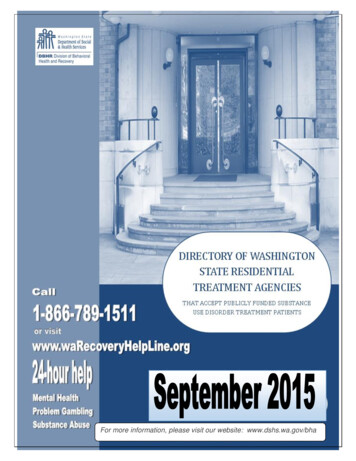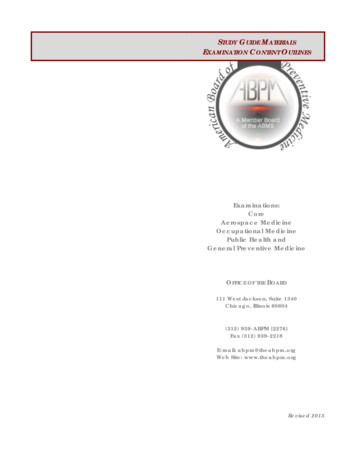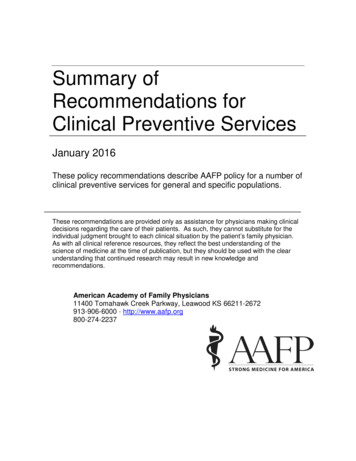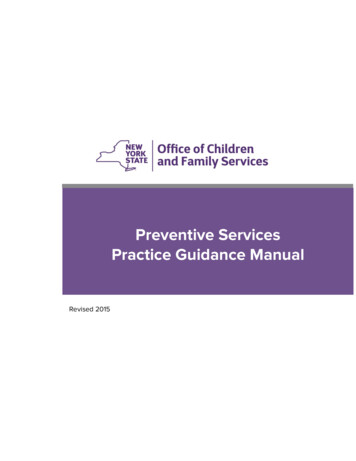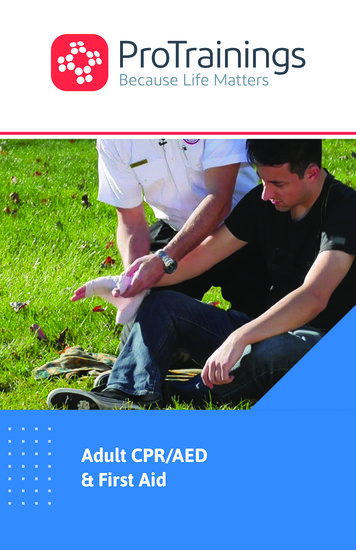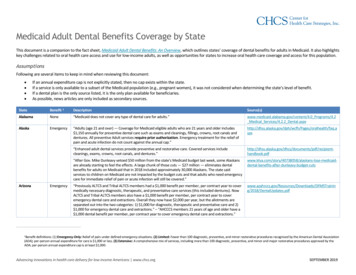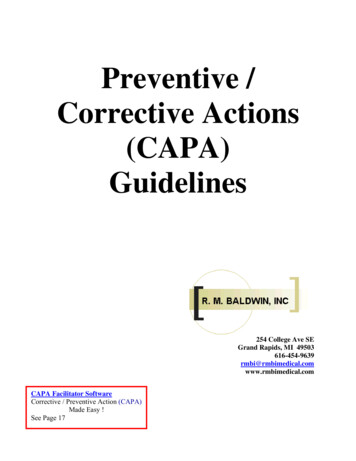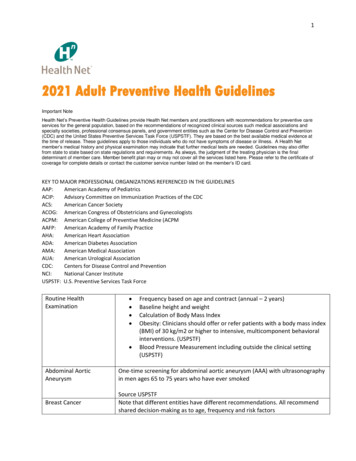
Transcription
12021 Adult Preventive Health GuidelinesImportant NoteHealth Net’s Preventive Health Guidelines provide Health Net members and practitioners with recommendations for preventive careservices for the general population, based on the recommendations of recognized clinical sources such medical associations andspecialty societies, professional consensus panels, and government entities such as the Center for Disease Control and Prevention(CDC) and the United States Preventive Services Task Force (USPSTF). They are based on the best available medical evidence atthe time of release. These guidelines apply to those individuals who do not have symptoms of disease or illness. A Health Netmember’s medical history and physical examination may indicate that further medical tests are needed. Guidelines may also differfrom state to state based on state regulations and requirements. As always, the judgment of the treating physician is the finaldeterminant of member care. Member benefit plan may or may not cover all the services listed here. Please refer to the certificate ofcoverage for complete details or contact the customer service number listed on the member’s ID card.KEY TO MAJOR PROFESSIONAL ORGANIZATIONS REFERENCED IN THE GUIDELINESAAP:American Academy of PediatricsACIP:Advisory Committee on Immunization Practices of the CDCACS:American Cancer SocietyACOG: American Congress of Obstetricians and GynecologistsACPM: American College of Preventive Medicine (ACPMAAFP: American Academy of Family PracticeAHA:American Heart AssociationADA:American Diabetes AssociationAMA:American Medical AssociationAUA:American Urological AssociationCDC:Centers for Disease Control and PreventionNCI:National Cancer InstituteUSPSTF: U.S. Preventive Services Task ForceRoutine HealthExamination Frequency based on age and contract (annual – 2 years)Baseline height and weightCalculation of Body Mass IndexObesity: Clinicians should offer or refer patients with a body mass index(BMI) of 30 kg/m2 or higher to intensive, multicomponent behavioralinterventions. (USPSTF)Blood Pressure Measurement including outside the clinical setting(USPSTF)Abdominal AorticAneurysmOne-time screening for abdominal aortic aneurysm (AAA) with ultrasonographyin men ages 65 to 75 years who have ever smokedBreast CancerSource USPSTFNote that different entities have different recommendations. All recommendshared decision-making as to age, frequency and risk factors
2Some states regulations allow for baseline mammography starting at age 35.USPSTFBiennial screening mammography for women aged 50 to 74 years at averagerisk. The decision to start screening mammography in women prior to age 50years and to continue past the age of 74 should be an individual oneACOGWomen at average risk should be offered mammography at age 40 but shouldstart at 50. Women at average risk of breast cancer should have screeningmammography every one or two years based on an informed, shared decisionmaking process Beyond age 75 years, the decision to discontinue screeningmammography should be based on a shared decision making.American Cancer Society (average risk) Women 40 – 44 years of age annual if desired Women 45-45 annual Women 55 and older could switch to every 2 yearsBRCA TESTING:Sources: USPSTF, ACOG, ACSProviders should assess women with a personal or family history of breast,ovarian, tubal, or peritoneal cancer or who have an ancestry associated withbreast cancer susceptibility 1 and 2 (BRCA1/2) gene mutations with anappropriate brief familial risk assessment tool. Women with a positive result onthe risk assessment tool should receive genetic counseling and, if indicatedafter counseling, genetic testing.Source: USPSTF 2019Cervical Cancer Screening Cervical cancer screening should begin at age 21 years. Women younger than 21 should not be screened, except for women whoare infected with HIV. More frequent screening is appropriate for certainwomen, including those infected with HIV. Cervical cytology alone should be used for women aged 21 to 29 years, andscreening should be performed every three years unless there is anabnormal result. In women aged 30–65 years, screening with cytology alone every 3 years orhrHPV testing alone ever 5 yrs is acceptable. Annual screening need not beperformed unless there is an abnormal result. Women younger than 30 years should not undergo co-testing. Screening should be discontinued after age 65 years in women withadequate negative prior screening test results. Routine cytology and HPV testing should be discontinued and not restartedfor women who have had a total hysterectomy and never had cervicalintraepithelial neoplasia 2 or higher. Women who have a history of cervical cancer, have HIV infection, areimmunocompromised, or were exposed to diethylstilbestrol in utero shouldnot follow routine screening guidelines and may need more frequentscreening.
3Adequate negative prior screening results are defined as three consecutivenegative cytology results or two consecutive negative co-test results within theprevious 10 years, with the most recent test performed within the past 5 years.Colorectal Cancer (CRC)ScreeningSource: ACOG and USPSTFNote that different entities have different recommendations but allrecommend shared decision-making as to age, frequency and risk factorsScreen age 45 or 50-75 for colorectal cancer using: Guaiac Fecal Occult Blood Test (gFOBT) annually or; Fecal Immunochemical Testing (FIT) annually or; Fecal Immunochemical Testing (FIT)-DNA every 1-3 years or; Flexible sigmoidoscopy every 5 years or; Flexible sigmoidoscopy every 10 years with FIT annually or; Colonoscopy every 10 years or; CT Colonography every 5 yearsFor patients at high risk, colonoscopy should start at age 40 with screeninginterval every 5-10 years. Note: Single–panel gFOBT performed in the medicaloffice using a stool sample collected during a digital rectal examination is not arecommended option for CRC screening due to its very low sensitivity foradvanced adenomas and cancer.Some entities (such as the American Cancer Society) recommend annualcolorectal cancer screening in the 45 to 49 age group. The decision to startcolorectal cancer screening before the age of 50 years should be an individualone and consider patient context, disease risk, and include the patient’spreferences and values regarding specific benefit and harm.Lung CancerProstate Cancer(Prostatic SpecificAntigen- PSA)Sources: USPSTF, American Cancer SocietyScreen annually for lung cancer with low-dose computed tomography in adultsages 50 to 80 years who have a 20 pack-year smoking history and currentlysmoke or have quit within the past 15 years. Screening should be discontinuedonce a person has not smoked for 15 years or develops a health problem thatsubstantially limits life expectancy or the ability or willingness to have curativelung surgery.Source: USPSTF (revised 2021)AUA For men between 40 and 54 at average risk, screening may not berecommended, however for men at high risk (based on ethnicity, familyhistory of prostate and other cancers), decision to screen should be makewith provider Men ages 55 to 69 need to make a shared decision about prostate cancerscreening with their clinician
4ACS The American Cancer Society emphasizes informed decision making forprostate cancer screening after discussion with provider:.o Age 50 for men who are at average risk of prostate cancer and areexpected to live at least 10 more years.o Age 45 for men at high risk of developing prostate cancer. Thisincludes African Americans and men who have a first-degreerelative (father or brother) diagnosed with prostate cancer at anearly age (younger than age 65).o Age 40 for men at even higher risk (those with more than one firstdegree relative who had prostate cancer at an early age).USPSTF (C rating) For men aged 55 to 69 years, the decision to undergo periodic prostatespecific antigen (PSA)–based screening for prostate cancer should be anindividual one. The USPSTF recommends against PSA-based screening for prostate cancerin men 70 years and olderOsteoporosis (BoneMineral Density Testing)Abnormal Glucose orType 2 DiabetesScreeningSource: USPSTF, ACS, AUAAll women aged 65 years or older and in younger women who are at increasedrisk for osteoporotic fracturesSource: USPSTFScreening for abnormal blood glucose as part of cardiovascular risk assessmentin adults aged 40 to 70 years who are overweight or obese. Persons with riskfactors such as family history of diabetes or of certain ethnicities or race couldstart screening sooner. Clinicians should offer or refer patients with abnormalblood glucose to intensive behavioral counseling interventions to promote ahealthful diet and physical activityThe ADA recommends screening should be considered in adults of any age whoare overweight or obese (BMI 25 kg/m2) and who have one or more additionalrisk factors for diabetes. In those without these risk factors, testing shouldbegin at age 45 years. If tests are normal, repeat testing should be carried outat least at 3-year intervals.Evidence on the optimal rescreening interval for adults with an initial normalglucose test is limited. Studies suggest that rescreening every 3 y may be areasonable approachCholesterol/LipidsSource: USPSTF, ADARecommendations vary but in general: Screen men age 35 and older for lipid disorders. Screen women age 45 and older for lipid disorders if they are at increasedrisk for coronary heart disease. Men age 20 to 35 and women age 20 to 45 that are at increased risk forcoronary heart disease should be screened for lipid disorder.
5 Hepatitis BReasonable options for screening interval include: every 5 years; screeningat 5 year intervals for people who have lipid levels close to thosewarranting therapy; and screening at intervals 5 years for low-risk peoplewho have had low or repeatedly normal lipid levels.Source: USPSTF, AHA Screen persons at high risk for infection (such as geographic location, HIVpositive, immunocompromised, household contacts or sexual partners ofpersons with HBV infection, injection drug use) using hepatitis B surfaceantigen (HbsAg) tests followed by a confirmatory test for initiallyreactive results. Hepatitis CHumanImmunodeficiency Virus(HIV) InfectionScreen pregnant women at their first prenatal visit.Source: USPSTF Screen all adults 18 – 79 years of ageSource: USPSTF Screen for HIV infection in adults age 15 to 65 years. Younger adolescents and older adults who are at increased risk should alsobe screened. Screen all pregnant women for HIV, including those who present in laborwho are untested and whose HIV status is unknown. The evidence is insufficient to determine optimum time intervals for HIVscreening.Prevention thru medication prophylaxis:Clinicians offer preexposure prophylaxis (PrEP) with effective antiretroviraltherapy to persons who are at high risk of HIV acquisition.Sexually TransmittedInfections (STI)Screenings andCounseling:Syphilis, Chlamydia,gonorrheaSource: USPSTF 2019Screen sexually active and those at high risk:SyphilisScreen pregnancy women and those at high risk for infection such those with ahistory of incarceration, history of commercial sex work, certain racial/ethnicgroups, and being a male younger than 29 years, as well as regional variations.ChlamydiaAll sexually active women 24 years of age or younger, including adolescents, areat increased risk for chlamydial infection. The CDC recommends at least annualscreening for chlamydia for women at increased risk. The USPSTF recommendsscreening for chlamydia in sexually active women age 24 years and younger andin older women who are at increased risk for infection.GonorrheaAll sexually active women age 24 and younger and in older women who are atincreased risk for infection. In the absence of studies on screening intervals, areasonable approach would be to screen patients whose sexual history reveals
6new or persistent risk factors since the last negative test result. Risk factors forgonorrhea and chlamydia include a history of previous infection, other sexuallytransmitted infections, new or multiple sexual partners, inconsistent condomuse, sex work and drug abuseCounseling:Intensive behavioral counseling for adults who are at increased risk for sexuallytransmitted infections (STIs)DepressionTobaccoSource: USPSTF, CDCScreening for depression in the general adult population is recommended,including pregnant and postpartum women. Screening should be implementedwith adequate systems in place to ensure accurate diagnosis, effectivetreatment, and appropriate follow-up.Source: USPSTFScreen all adults, including pregnant women, about tobacco use andtobacco cessation interventions for those who use tobacco products (includinge-cigarettes and vaping) and pregnancy-tailored counseling for pregnantwomen who use tobacco.The USPSTF recommends that primary care clinicians provide interventions,including education or brief counseling, to prevent initiation of tobacco useamong school-aged children and adolescentsUnhealthy Drug Use:ScreeningAlcohol MisuseIntimate PartnerViolenceFall Prevention in OlderAdultsSource: USPSTF The USPSTF recommends screening by asking questions about unhealthydrug use in adults age 18 years or older. Screening should be implemented when services for accurate diagnosis,effective treatment, and appropriate care can be offered or referred.Screen adults 18 and over for alcohol misuse and provide persons engaged inrisky or hazardous drinking with brief counseling interventions to reducealcohol misuseSource: USPSTFScreen women of childbearing age for intimate partner violence, such asdomestic violence, and provide or refer women who screen positive tointervention services.Source: USPSTFExercise interventions are recommended to prevent falls in communitydwelling adults 65 years or older who are at increased risk for falls.Source: USPSTF
7Aspirin StatinsLow-dose aspirin use for the primary prevention of cardiovascular disease(CVD) and colorectal cancer (CRC) in adults aged 50 to 59 years who have a10% or greater 10-year CVD risk, are not at increased risk for bleeding, havea life expectancy of at least 10 years, and are willing to take low-doseaspirin daily for at least 10 years.The decision to initiate low-dose aspirin use for the primary prevention ofCVD and CRC in adults aged 60 to 69 years who have a 10% or greater 10year CVD risk should be an individual one. Persons who are not at increasedrisk for bleeding, have a life expectancy of at least 10 years, and are willingto take low-dose aspirin daily for at least 10 years are more likely to benefit.Source: USPSTFAdults without a history of cardiovascular disease (CVD) (ie, symptomaticcoronary artery disease or ischemic stroke) are recommended to use a low- tomoderate-dose statin for the prevention of CVD events and mortality when allthe following criteria are met: aged 40 to 75 years; have 1 or more CVD risk factors (ie, dyslipidemia, diabetes,hypertension, or smoking); have a calculated 10-year risk of a cardiovascular event of 10% orgreater.Identification of dyslipidemia and calculation of 10-year CVD event risk requiresuniversal lipids screening in adults aged 40 to 75 yearsBreast Cancer RiskReducing MedicationsFolic AcidPregnancyNewbornsSource: USPSTFClinicians may offer to prescribe risk-reducing medications, such as tamoxifen,raloxifene, or aromatase inhibitors, to women who are at increased risk forbreast cancer and at low risk for adverse medication effectsUSPSTFAll women planning or capable of pregnancy should take a daily supplementcontaining 0.4 to 0.8 mg (400 to 800 µg) of folic acid.Source: USPSTF Screening for asymptomatic bacteriuria using a urine culture Screening for hepatitis B at the first prenatal visit. Screen all pregnant women for HIV, including those who present in laborwho are untested and whose HIV status is unknown and repeat screening isbased on risk factors Refer pregnant and postpartum persons who are at increased risk ofperinatal depression to counseling interventionsSource: USPSFTRefer to the American College of Obstetricians and Gynecologists Guidelines forPreconception Care, Prenatal Care and Postpartum CareProphylactic ocular topical medication for all newborns to prevent gonococcalophthalmia neonatorum
8Source: USPSTF 2019Please refer to the AAP Bright Futures for information on pediatric guidelinesCounselingAdvance DirectivesAvoidance of tobacco and/or tobacco cessationCalcium intakeCoping Skills/Stress ReductionDepression screening for postpartum, MI, CVA and for those with chronicmedical conditionsDiscuss chemoprevention for breast cancer if high riskDomestic Violence (e.g., Intimate Partner Violence and Elderly Abuse; refer tointervention services if applicable)Fire safety (smoke detectors)Firearm storageHealthy Diet and Physical Activity for Cardiovascular Disease Prevention in AdultsWith Cardiovascular Risk Factors: Behavioral Counseling InterventionsHIV screening and counselingHormone Replacement Therapy: Counsel women 45 and older for pros and consImmunizations/VaccinationsInjury and fall preventionMental Health AwarenessMinimizing exposure to ultraviolet radiation to reduce risk for skin cancerPromote benefits of physical activityPromotion of healthy dietRisks and symptoms of endometrial cancer to women of average risk at the timeof menopause. Strongly encourage women to report and unexpected bleeding orspottingSeat belt use, helmet useTuberculosis screening if at riskUnwanted Pregnancy PreventionVitamin D supplementationWeight loss for obese adultsReview History: January 2003, March 2004, March 2005, April 2006, February 2007, February 2008,March 2009, February 2010, February 2011, February 2012, November 2012, February 2013, May 2013,February 2014, February 2015, May 2015, February 2016, May 2016, February 2017, April 2017, March2018, September 2018, February 2019, February 2020, February 2021
2021 Adult Preventive Health Guidelines Important Note Health Net’s Preventive Health Guidelines provide Health Net members and practitioners with recommendations for preventive care services for the general population, based on the recommendations of
